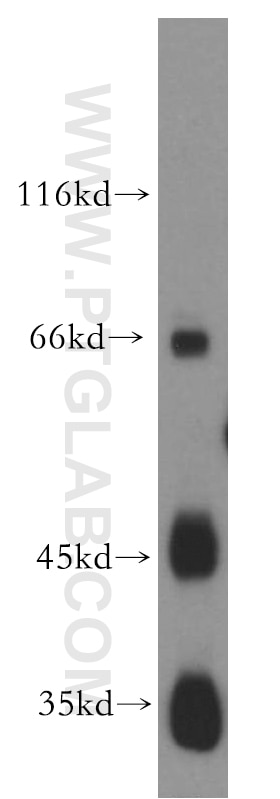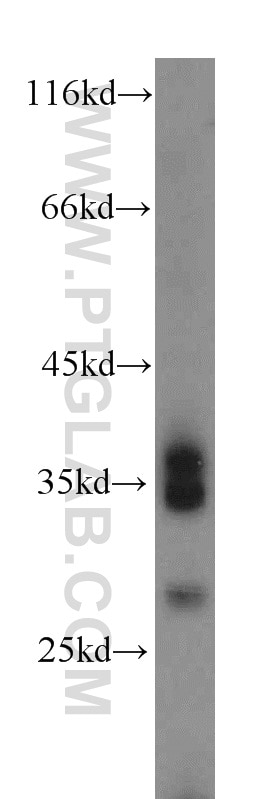Validation Data Gallery
Tested Applications
| Positive WB detected in | human placenta tissue, human heart tissue |
Recommended dilution
| Application | Dilution |
|---|---|
| Western Blot (WB) | WB : 1:500-1:2000 |
| It is recommended that this reagent should be titrated in each testing system to obtain optimal results. | |
| Sample-dependent, Check data in validation data gallery. | |
Published Applications
| WB | See 3 publications below |
Product Information
12972-1-AP targets JAM2 in WB, ELISA applications and shows reactivity with human, mouse, rat samples.
| Tested Reactivity | human, mouse, rat |
| Cited Reactivity | human, mouse, rat |
| Host / Isotype | Rabbit / IgG |
| Class | Polyclonal |
| Type | Antibody |
| Immunogen |
CatNo: Ag3431 Product name: Recombinant human JAM2 protein Source: e coli.-derived, PGEX-4T Tag: GST Domain: 1-298 aa of BC017779 Sequence: MARRSRHRLLLLLLRYLVVALGYHKAYGFSAPKDQQVVTAVEYQEAILACKTPKKTVSSRLEWKKLGRSVSFVYYQQTLQGDFKNRAEMIDFNIRIKNVTRSDAGKYRCEVSAPSEQGQNLEEDTVTLEVLVAPAVPSCEVPSSALSGTVVELRCQDKEGNPAPEYTWFKDGIRLLENPRLGSQSTNSSYTMNTKTGTLQFNTVSKLDTGEYSCEARNSVGYRRCPGKRMQVDDLNISGIIAAVVVVALVISVCGLGVCYAQRKGYFSKETSFQKSNSSSKATTMSENDFKHTKSFII 相同性解析による交差性が予測される生物種 |
| Full Name | junctional adhesion molecule 2 |
| Calculated molecular weight | 298 aa, 33 kDa |
| Observed molecular weight | 33 kDa, 43 kDa |
| GenBank accession number | BC017779 |
| Gene Symbol | JAM2 |
| Gene ID (NCBI) | 58494 |
| RRID | AB_10638910 |
| Conjugate | Unconjugated |
| Form | |
| Form | Liquid |
| Purification Method | Antigen affinity purification |
| UNIPROT ID | P57087 |
| Storage Buffer | PBS with 0.02% sodium azide and 50% glycerol{{ptg:BufferTemp}}7.3 |
| Storage Conditions | Store at -20°C. Stable for one year after shipment. Aliquoting is unnecessary for -20oC storage. |
Protocols
| Product Specific Protocols | |
|---|---|
| WB protocol for JAM2 antibody 12972-1-AP | Download protocol |
| Standard Protocols | |
|---|---|
| Click here to view our Standard Protocols |
Publications
| Species | Application | Title |
|---|---|---|
Cell Microbiol Porphyromonas gingivalis induces penetration of lipopolysaccharide and peptidoglycan through the gingival epithelium via degradation of coxsackievirus and adenovirus receptor. | ||
Diabetes Res Clin Pract Heparanase-driven inflammation from the AGEs-stimulated macrophages changes the functions of glomerular endothelial cells. | ||
Mol Cell Endocrinol PPM1G dephosphorylates α-catenin to maintain the integrity of adherens junctions and regulates apoptosis in Sertoli cells |


